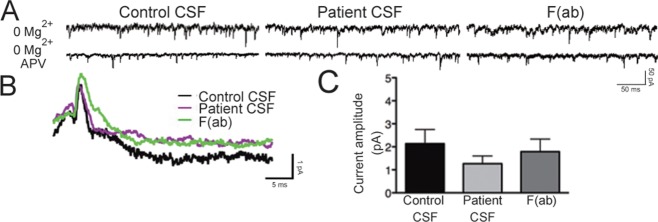FIGURE 5.

Patient antibodies do not acutely antagonize the N-methyl-D-aspartate receptor (NMDAR). (A) Representative traces of α-amino-3-hydroxy-5-methylisoxazole-4-propionic acid receptor (AMPAR)-mediated and NMDAR-mediated miniature excitatory postsynaptic currents (mEPSCs) from whole cell patch clamp recordings of hippocampal neurons following treatment with control or patient cerebrospinal fluid (CSF) for 30 minutes or F(ab) fragments for 24 hours. Recordings were made in the presence of tetrodotoxin, picrotoxin, and 0mM Mg2+ to isolate dual glutamatergic currents. In the lower traces, amino-phosphonovaleric acid (APV) was added to block the NMDAR-mediated portion of the mEPSC. (B) Representative averaged NMDAR-mediated mEPSCs recorded from neurons in different treatment conditions. The difference between the 0mM Mg2+ condition and the 0mM Mg2+ plus APV condition is plotted, showing the NMDAR current. (C) Quantification of NMDAR current amplitude following treatment (n = 5–10 cells per condition). Amplitude was not significantly different: 2.14 ± 0.62pA, control CSF; 1.26 ± 0.34pA, patient CSF; 1.79 ± 0.55pA, F(ab) fragments; 1-way analysis of variance, p > 0.05.
